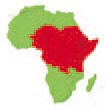DK People & Places: East & Central Africa
- HOW CAN THE ANIMALS BE PROTECTED?
- WHAT IS THREATENING AFRICA’S WILDLIFE?
- HOW DOES THE EQUATOR AFFECT THE LANDSCAPE?
- RIFT VALLEY
- IS NIGERIA RICH?
- WHAT WORK DO PEOPLE DO IN THIS REGION?
- WHAT DO LOCAL PEOPLE CALL THE CONGO RIVER?
- WHY DOES FAMINE KEEP OCCURRING?
- FACTFILE: EAST & CENTRAL AFRICA
- FIND OUT MORE
Central Africa is a hugely fertile region, with abundant grasslands, vast tropical rainforests, and many rivers and lakes. Both Niger and Chad are mostly desert, however, and in recent years, Lake Chad has shrunk to one-tenth of its former size as the rivers that feed it have dried up. Although many of the countries have great agricultural and mineral wealth, political instability and civil wars have kept people in this region in great poverty.
Governments have established huge national parks and wildlife reserves, such as the Masai Mara in Kenya and the Serengeti in Tanzania. Here, tourists can go on a safari to view the animals in their natural habitat, contributing much-needed income to both local and national economies.
Africa has an amazing variety of wildlife, but in recent years, many species have come under threat from hunters. Elephants are prized for their ivory tusks, black rhinoceroses for their horns. These and other species are now threatened with extinction, while some species have been lost forever.
Africa is the only continent through which the equator and both tropics (Capricorn and Cancer) run. Around the equator itself, high rainfall has created a watery landscape of lakes, rivers, and lush tropical rainforest. On either side of the equator, the climate and vegetation roughly mirror each other, with huge deserts forming in the hot and rain-starved land around each tropic.
The East African Rift stretches for 3,000 miles (4,830 km) from Syria in western Asia south through the Red Sea and East Africa to Mozambique. Its landscape is extraordinary, with many deep lakes, steep-sided valleys, vast plateaus, and volcanic peaks.
Nigeria is potentially the richest nation in Africa, with huge reserves of oil, natural gas, coal, tin, and iron ore. It also has abundant fertile land, capable of growing cotton, coffee, sugar, and many other crops. However, corruption and bad government have meant that the money earned from these natural resources has not been used properly, and most Nigerians remain very poor.
Most rural Africans live off the land, tending herds of cattle, sheep, and goats, and growing food crops such as corn, cassava, and yams. In East Africa, many also work on the tea and coffee plantations or earn a living from tourism in the many wildlife reserves. The oil industries of Nigeria and Cameroon and the mineral mines of Congo employ thousands of people.
The Congo River is known locally as the Zaire. It runs in a huge, upturned U-shape through the Democratic Republic of Congo, previously known as Zaire. The river is a lifeline for the Congolese people, providing fresh water, fish, irrigation for crops along its banks, and a vital transportation system.
Ethiopia and Somalia have both endured lengthy civil wars in recent years, leaving many people homeless and destitute and creating millions of refugees. Both countries have also been affected by drought, crop failure, and the overfarming of poor or exhausted land. This intense pressure on hugely overstretched resources means that famine occurs regularly.

